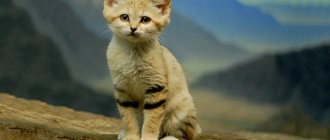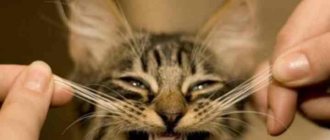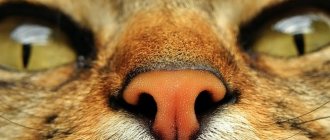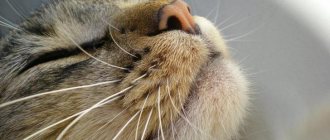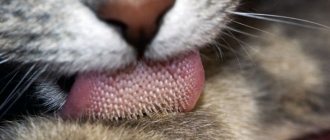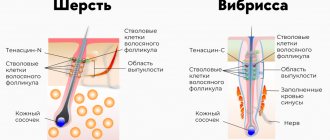Whiskers for cats are an extremely important attribute that performs not only a decorative role, but is necessary for orientation in space. Almost all predators and other mammals, as a result of evolutionary processes, acquired a similar unique “navigation” system. Whiskers allow cats to feel quite calm at night and not bump into objects.
Although whiskers are derivatives of the skin, such as fur, they are not exactly hair. There is an assumption that ancient cats had mustaches before thick fur appeared.
Tactile detectors, or as the cat's whiskers are also called, are thicker than the hairs of the coat. In complete darkness, when the animal’s vision does not allow it to distinguish objects, the mustache comes to the rescue. The specific vibration emanating from the mustache allows you to obtain detailed information about surrounding objects or a potential enemy. Tactile detectors play an extremely important role during a fight with relatives or during the hunt for prey.
Whiskers on cats and cats are located not only in the cheek area, as many owners believe. They are located in the eyebrows, chin and even on the forelimbs. A winning tactic is to line up during a fight by capturing the exact body position of a potential opponent.
What is the correct name for a mustache and why?
A cat's whiskers play the most important role in sensing space, being a kind of detectors or receptors formed as a result of evolutionary processes. With the help of their whiskers, cats even receive information about changes in atmospheric pressure, so most folk signs are associated with the behavior of domestic cats.
A cat's whiskers are scientifically called vibrissae. The word comes from the Latin - vibro (vibrate, fluctuate). Vibrissae are a kind of organ of touch that allows animals to navigate in complete darkness. As you know, whiskers are located not only on the muzzle, but are also present on the paws, allowing you to obtain the most detailed information about objects. The most sensitive vibrissae are located in the area of the upper lip and chin, under the eyes.
The structure of the vibrissae is much thicker than the usual hair shaft. Each whisker has its own muscle fibers that are responsible for its movement. In addition, it is worth noting that the whiskers do not fall out on their own during seasonal molting, and are also formed in the prenatal period earlier than the coat.
In addition, a nerve impulse departs from each vibrissa to the cerebral cortex. This makes it possible to interpret the information received from the tactile detector as accurately as possible. Each cat's whiskers are well supplied with blood and also have access to the trigeminal nerve.
The vibrissae are so sensitive that at the slightest movement of air, they send signals to the brain regarding the position of the body in space.
Need for a haircut
During life, whiskers, like ordinary hair, grow, age, and fall out, but new ones will certainly grow in place of those that fall out, and only in old cats does this process slow down, as does the activity of the animal itself. If you deliberately trim a cat's whiskers, you can assume that she has switched off an important organ that helps her survive.
Soon the new whiskers will grow, and she will be able to feel good again, but without them it is extremely difficult for the cat. Cutting it off can cause incredible pain to your pet, because the whiskers are very sensitive to touch.
Studies have revealed the following behavioral problems in animals with trimmed whiskers:
- Orientation in space has worsened, especially at night.
- The ability to assess the size of holes in relation to the size of one’s own body has decreased.
- Some cats, after trimming their whiskers, looked scared, were aggressive, and their behavior became inappropriate.
- It has been observed that the smartest cats bite off the whiskers of their relatives in order to subjugate them.
- The ability to estimate the distance to an object to make a jump is reduced.
But, like any rule, there are exceptions. Sphynx cats have either few or no whiskers, but this does not prevent them from navigating in space and hunting.
Features of the structure of whiskers in cats and cats
Vibrissae have a whole range of anatomical differences from the coat. The base of a cat's whisker is unusually rigid and long, but at the same time has high elasticity. The vibrissa follicle is located in the upper layers of the skin, supplied with blood.
The root of the tactile detector is located directly in a special sac, surrounded by receptors and a large number of nerve endings. This allows you to capture even the smallest air movements.
Each vibrissae has its own anatomically determined location. Striated muscle fibers are responsible for the movements of a cat's whiskers.
The system for interpreting the data obtained is of greatest interest. Thus, the information received from the vibrissae travels in the form of nerve impulses along the trigeminal nerve. Once it enters the brain, it is processed, and the animal receives a picture of what is happening in several dimensions.
The vibrissae are the first hairs to develop in kittens in the womb. Therefore, it is almost impossible to sneak up on a cat unnoticed, even in the dark. The only way to catch a cat by surprise is if the enemy approaches from a downwind area.
How many whiskers a cat has is of interest to many owners. This makes it possible to promptly notice the lack of important tactile detectors and indicate possible problems. So, a healthy cat has only 24 vibrissae on its face, 12 on each side in 4 rows.
Prevention methods
In order for the cat to feel good, be healthy, please the owner’s eyes and not lose its whiskers, you need to take some preventive measures:
- Frequently ventilate and humidify the air in various ways.
- Monitor the quality of food, provide access to plenty of fresh and clean water.
- Treat your pet for parasites and get vaccinations in a timely manner.
- Do not trim the animal's whiskers.
- Do not give medications not prescribed by a veterinarian.
Vibrissae do not simply decorate a cat, but are part of a sense organ ; they allow the animal to be in comfortable conditions and help navigate, especially in the dark. Without them, a domestic cat will not die, but its quality of life will noticeably decrease, it will suffer and be stressed until new ones grow.
The pet may become frightened and absent-minded, and may also become angry at its owner or the child who “joked” like that, so you should not conduct experiments on the animal.
What functions do whiskers perform in cats?
Being a natural predator, a cat should always be in excellent physical shape. And one of the main criteria is a good warning system that allows you to receive information from the environment. Vibrissae make it possible to receive information from a victim, even if it is not located in the field of view. The mustache allows you to control a potential victim and attack at the most opportune moment.
In addition, the vibrissae make it possible to determine the direction of the wind when making a jump and, if necessary, adjust the trajectory. If a cat's whiskers break, the functions of orientation in space undergo changes.
Cats' whiskers grow back after damage much more slowly than regular fur. It is also important to distinguish between a fallen vibrissae and a broken one. So, if a cat’s whisker has fallen out, it has a rounded end, and if the whisker is broken, its tip has a pronounced break.
There are many reasons why a cat's whiskers break. These may be physiological reasons as well as pathological factors. Disturbances in the cat’s nutrition have a negative impact on the condition of the entire coat and whiskers in particular. An acute deficiency of vitamin and mineral complexes leads to brittle hair and skin derivatives.
The cause of fragility of the whiskers may be inflammation on the muzzle as a result of injury and penetration of pathogenic bacterial microflora. Fragility of the whiskers is also caused by fungal pathologies that affect the pet’s face. An attentive owner should promptly note changes in health status and contact a veterinarian if a pathological process is suspected.
How do whiskers affect a cat's movements?
By catching air currents, a cat can reach high speed while running, make graceful jumps, accurately calculate the distance to the landing point, understand where the danger is coming from, and much more.
In addition, cats' orientation in space is also achieved through acute night vision and these horny hairs. The animal can sense an obstacle, find its way, and even hunt in the dark, relying on sensations from its antennae. For example, when a cat wants to crawl into a narrow hole or between the bars of a fence, the whiskers tell her whether this is possible. Many have noticed how a seemingly plump and fluffy cat passes through narrow cracks, because of this they even joke that cats are “liquid.” Cats are not at all afraid of getting stuck, because the length of their whiskers is constant, and they, like a ruler, easily measure the size of objects around them.
Interesting fact: the especially long hairs on the tips of cats' ears are arranged in a similar manner. They also help regulate movement, determine the source of sound, and even distinguish subtle rustling sounds in the dark. The third such “lever” in a cat’s body is the tail. This helps you maintain balance and “connect” with other people.
Can a cat live without whiskers?
Sometimes cats have to lose their whiskers. There are natural reasons for this. But sometimes inexperienced owners remove the cat’s whiskers “for beauty,” or the child cuts them out of curiosity. This procedure can have very unpleasant consequences for the cat, so trimming cats’ whiskers is strictly prohibited!
If a cat is left without a whisker, its spatial orientation, ability to move quickly, and recognize and evaluate food may be impaired. The animal may look depressed, sick, and confused. Cats are very sensitive to the deprivation of such an important tool as a whisker.
Even during treatment, the veterinarian will only remove these hairs if absolutely necessary. Fortunately, in most cases they grow back. Not always at full height, but, nevertheless, a normal state for a cat can be restored, and the animal will feel internal balance.
Interesting fact:
In some breeds the vibrissae are highly developed, in others they are not very bright. This is due to evolution, habitat changes and domestication. Breeds of small cats, closer to the wild, have powerful, hard whiskers, while domestic cats have soft and less dense whiskers. Maine Coon cats have the longest whiskers. Thus, in the Guinness Book of Records, the length is 19 cm. The owner of a luxurious mustache is the Finnish cat Missy of the named breed.
Why does a cat need a mustache?
The cat rightfully takes first place among the most cozy pets. Her purring calms and relaxes, her soft fur gives a pleasant feeling, and her unobtrusive nature makes communication comfortable. The structure of a cat sometimes raises many questions among lovers of this animal. In particular, whiskers: what are they for, what functions do they perform, how important is it for a cat to have them? It's time to look into this issue.
How to properly cut a cat's hair
When cutting hair, it is advisable to find an assistant. He will hold the animal lying on its side, control the front legs with one hand and the hind legs with the other. It is necessary to fix the pet on the table surface quite firmly - the cat will escape out of fear, and the sound of the running machine will provoke it to escape. Try to use silent machines. It is necessary to cut cats according to a certain algorithm: start cutting from the sides, back and belly, move to the armpits, then the back. Then come the paws; if you wish, you can leave the “socks”. It is not necessary to cut the tail, but if you decide to tidy it up, leave a tassel at the end. If you decide to cut your cat's hair against the grain, use scissors and a special clipper, setting the cutting depth to 3 to 4 mm, which will prevent injury to the animal's skin. Do not forget to stretch the animal's skin in the area where the machine passes. Cutting against the grain is different in that a larger volume of hair is removed in one pass, but this method is mentally traumatic for the animal. After finishing the haircut, wipe the cat with wet wipes, or better yet, give it a bath to remove any remaining fur. Now all the fears are over, and she is ready to return to her normal life. This process is not simple, it has many nuances, and not all animals tolerate haircuts calmly. If you do not have enough skills to groom your pet on your own, it is better to contact a groomer: go to a special salon or call them to your home.
